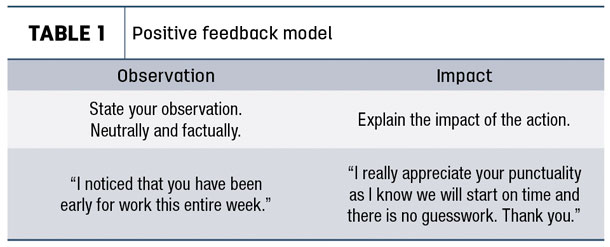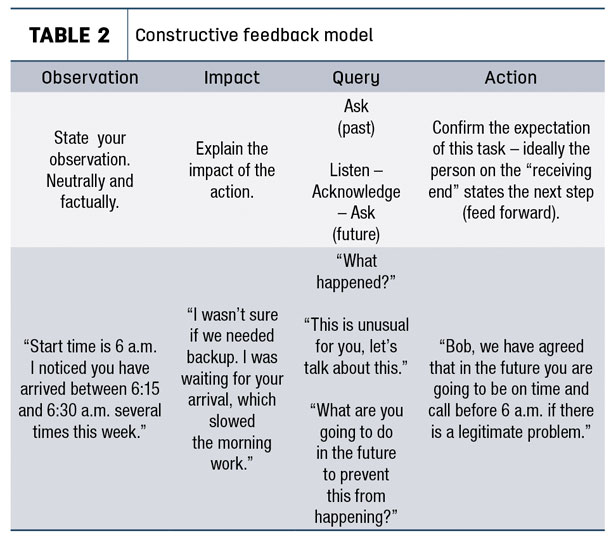Offering your team regular positive feedback on their work helps them feel valued. Constructive or feedforward information provides insights into your perspective, development and support for your team.
Let’s start with positive feedback.
“Catch people doing something right,” says Ken Blanchard, co-author of the One Minute Manager.
Gallup engagement surveys reveal that more than two-thirds of employees whose managers focused on their strengths were fully engaged in their work, as compared to less than a third of employees whose managers focused on their weaknesses.
Recognition has been proven to increase happiness at work in general and is linked to concrete results, such as job satisfaction and retention.
In the last 30 years, I have worked with thousands of leaders by coaching and facilitating workshops. Offering positive feedback is always included in our conversations in building teams. The absolute majority of leaders admit they do not receive adequate recognition from their own leader and yet, when asked for the barriers in recognizing their own team members, there are immediate and ample reasons for not doing what they know to be effective.
The following are reasons for not recognizing team members:
- I only give feedback when the work is truly exceptional. I pay people to do a job.
- I don’t have time to notice that level of detail.
- I don’t receive positive feedback myself, so why should I offer it?
- I’m not sure how the person will react, or they will ask me for something as a result.
- I’m concerned about what other team members will say.
- I don’t know how to word it without sounding odd.
- It isn’t in my nature to talk this way. People know what I think.
- I don’t think people want to hear that kind of thing.
- I don’t need positive reinforcement and don’t believe others should need it.
- People will get a swollen head.
Here is what we know to be true:
- People repeat behaviour that is recognized.
- Positive reinforcement is a training tool.
- The more we know we are valued by our leader, the easier it is to hear and respond to constructive feedback.
- The most powerful feedback is specific, timely and authentic.
- Telling your team members what you appreciate costs nothing.
How can positive feedback be given? Table 1 demonstrates a simple, effective positive feedback model. Try this and see the reaction you observe.

Now let’s explore the other side of the coin: constructive feedback when dealing with work that can be done better.
“Supporting the truth, even when it is unpopular, shows the capacity for honesty and integrity,” says Steve Brunkhorst, author of Achieve!
Here is a typical situation I often hear as a coach: Just talking about working with Stan creates anxiety for Paula. In a coaching session with me, Paula expresses her frustration. “He just never does what he is supposed to do. His work consistently hovers around the line of minimal contribution: never strong enough to really make a difference and never terrible enough to let him go. His attitude really irritates me; he gets under my skin.”
As Paula’s coach, my role is to clarify her confusion and help her develop and implement solutions. “What has he been told regarding his performance?” I ask her.
“It is hard to talk to him; he is immediately either on the defensive or the offensive. I have basically given up and just ignore him. It is too frustrating. I would rather just find some other way to get the work done,” Paula responds.
Another manager succumbs to the angst of holding people accountable.
On countless occasions in management training and coaching sessions over the past many years, I’ve listened to managers such as Paula describe the angst of confronting employees about poor performance. Actually, what I hear is their rationalizations for their reluctance to deal with what is undoubtedly a challenging and sometimes painful management responsibility.
The following are reasons for not dealing with employee performance issues:
- I don’t want to embarrass people.
- It isn’t worth the hassle.
- I don’t need the conflict and then have everyone talking about me.
- Everyone is different; maybe I don’t have the right to expect so much.
- I only end up losing sleep over situations like this; it’s easier to just ignore it.
- She should know this without me saying anything.
- Will my boss support me?
- I don’t have a lineup of good people who want to do this job.
- Their teammates will deal with it.
- I believe it will hurt the feelings of the other person.
- I don’t want to be seen as an uncaring leader.
- It might get ugly – conflict could arise.
- Not sure if that is what my boss wants me to do.
- What will the rest of the team do if this person complains to them about me?
- I don’t know how to deal with this.
- What if I have to fire them – who will replace them? Better the devil you know.
The truth is: The people who work hard want you, as a leader, to deal with people who don’t do their fair share. It is “disengaging” to observe that there is no consequence for poor performers, and your workplace will be affected by your reluctance to deal with difficult issues.
You, as manager, are responsible for 50% of the equation. When you are clear, specific, consistent, provide resources, training and ongoing feedback, you are doing your part. The employee is also responsible for 50%, to clarify anything that is vague, to track his own performance, to apply her skills and keep you apprised of barriers and issues that arise along the way. When people know what is expected, they have a choice to make – either do the work, as required, or don’t. Either way, there should be a consequence of their decision.
Feedback when a performance gap exists has many names: feedback for improvement, developmental feedback, constructive criticism and problem-solving feedback. Whatever you call it, there are certain key elements. Do your homework, have all the facts and information available and ensure the support of your boss, if you have one. Hold the discussion privately, without interruption and with ample time. Clarify your objective. What are you really trying to achieve? What is the best possible outcome of this conversation?
Remember this is a two-way discussion, and substitute curiosity for assumptions regarding the other side of the story. Start the conversation neutrally without accusation. Engage the person in the discussion as soon as possible. Explore all reasons for non-performance. Listen well, don’t rush this conversation. Work toward a solution that is balanced and achievable. Establish realistic timelines. Ask the person to follow up with you. Both of you should document the discussion.
In the July issue of Progressive Dairy, the Listen-Acknowledge-Ask model was described in full. In the October issue, SNIP – the emotional intelligence tool – was described. You require both of these tools for holding a constructive feedback conversation (see Table 2).

You will see the results of offering your team specific, authentic, timely and generous positive feedback. Confronting issues in an honest manner is a complex, challenging task, but dealing with performance issues proactively, consistently and objectively has its own rewards. Feelings of angst will be replaced by those of satisfaction. ![]()
PHOTO: Photo by Mike Dixon.
Kathleen Redmond, MA, MCC, serves leaders by focusing on character, culture and communication.

-
Kathleen Redmond
- Executive Coach, Corporate Facilitator, Author
- Adjunct Professor – University of Guelph
- Email Kathleen Redmond









